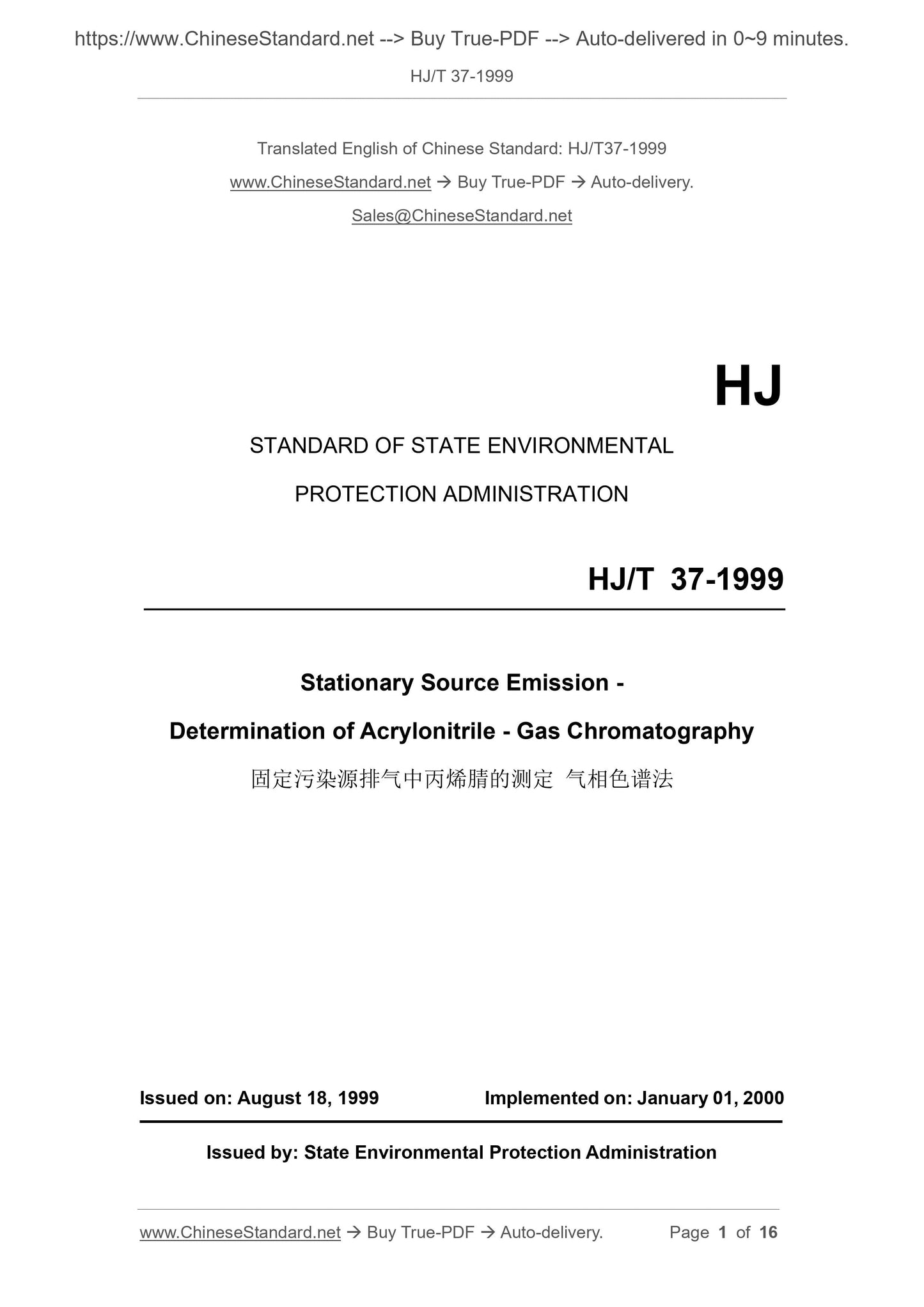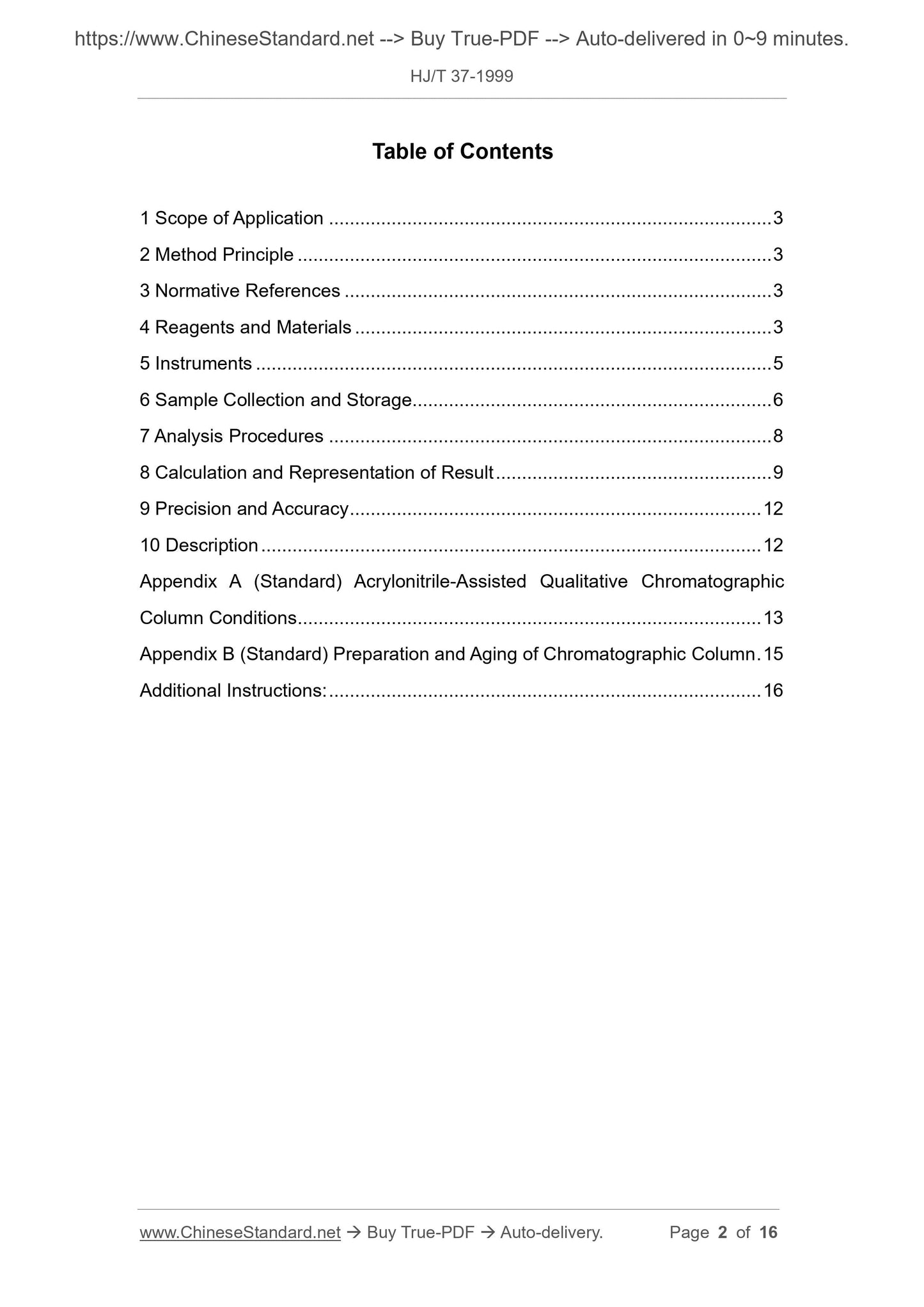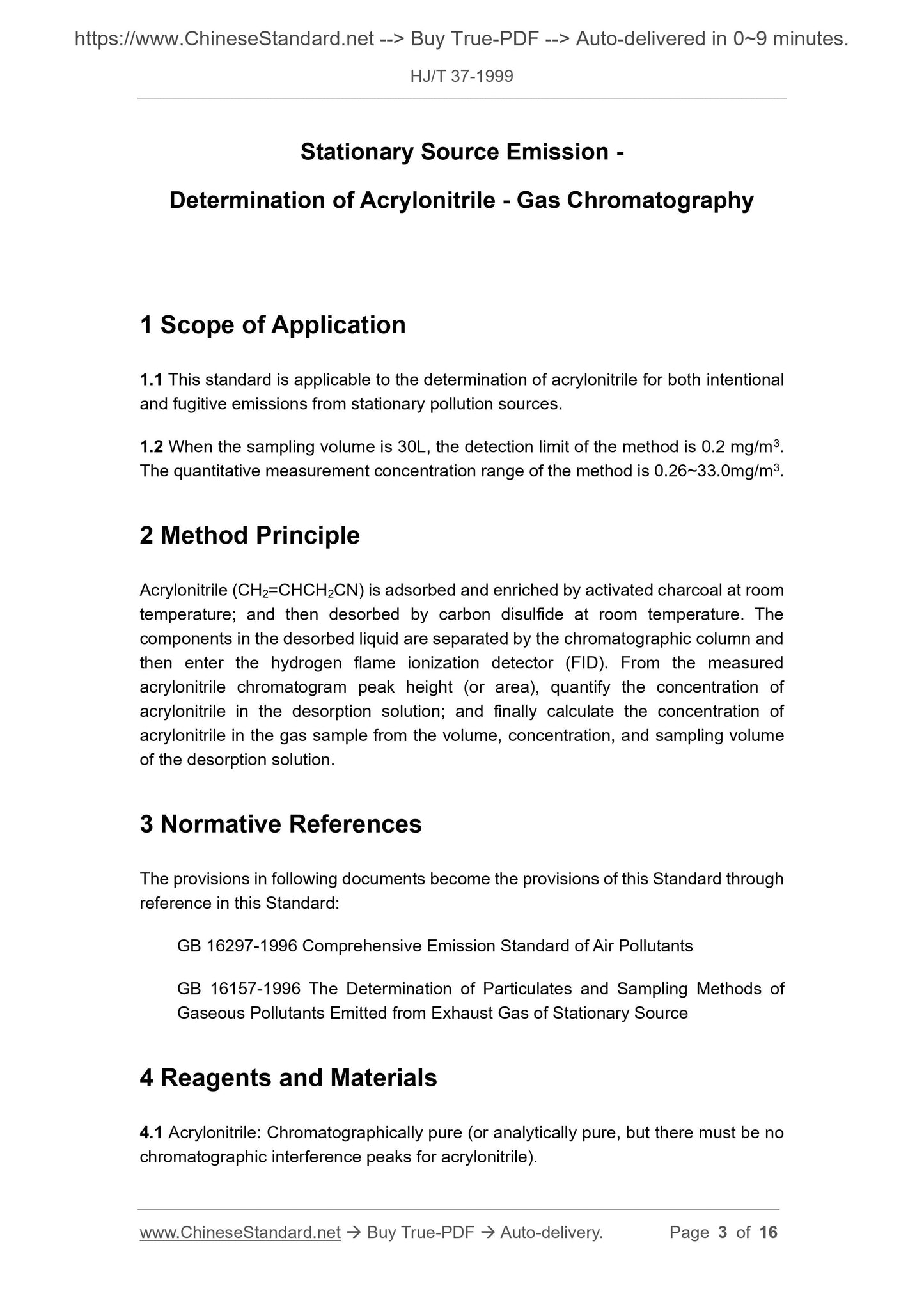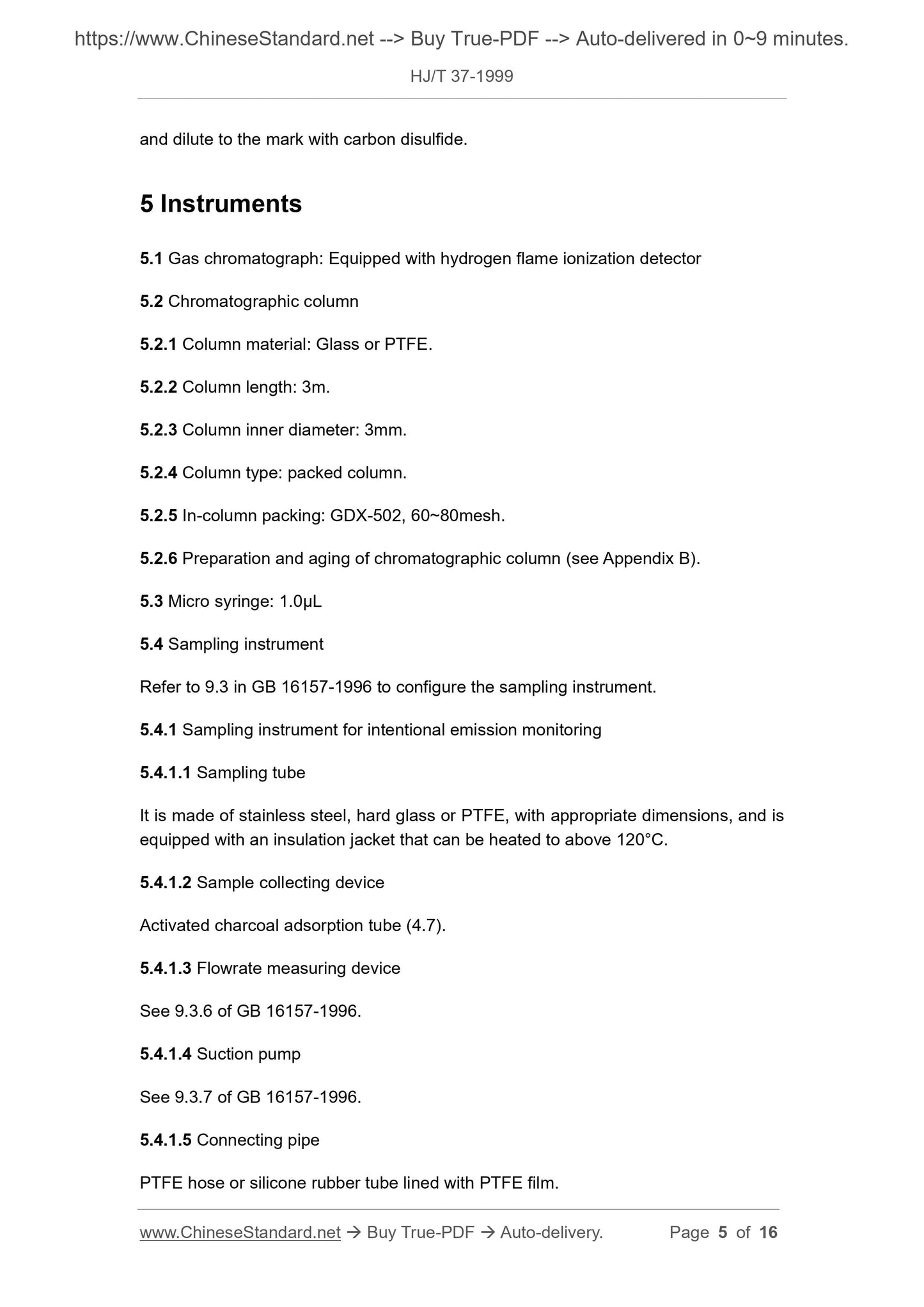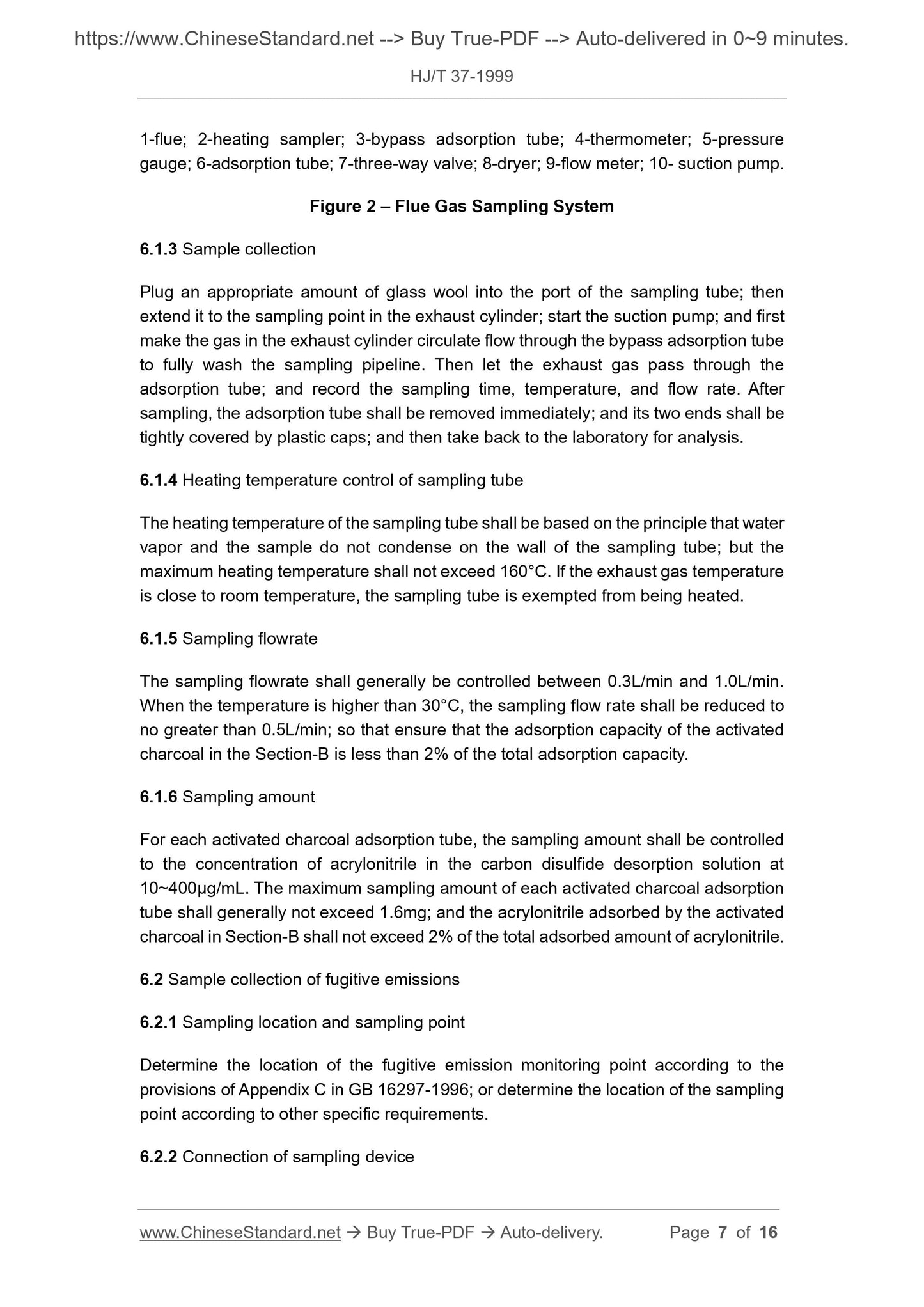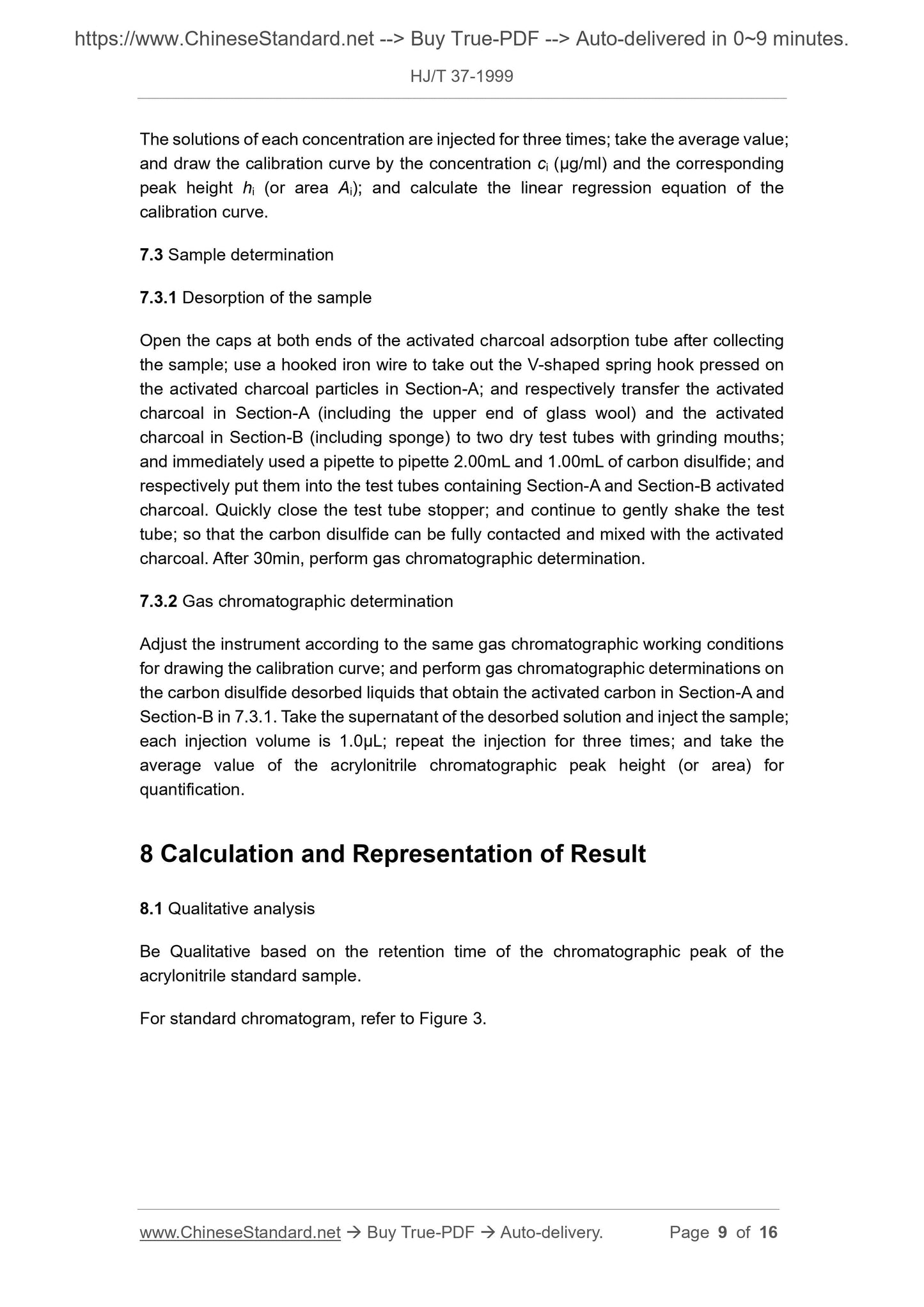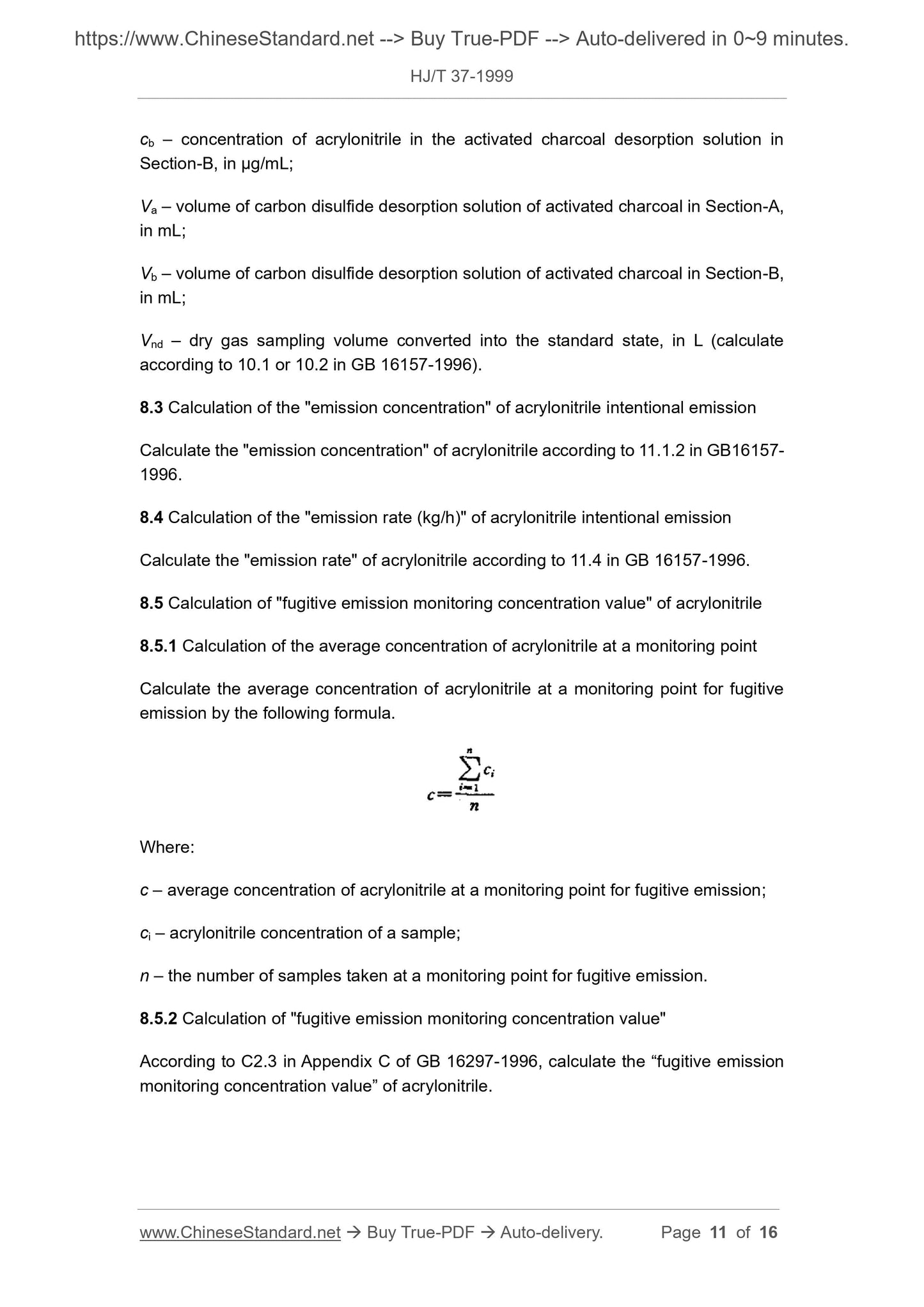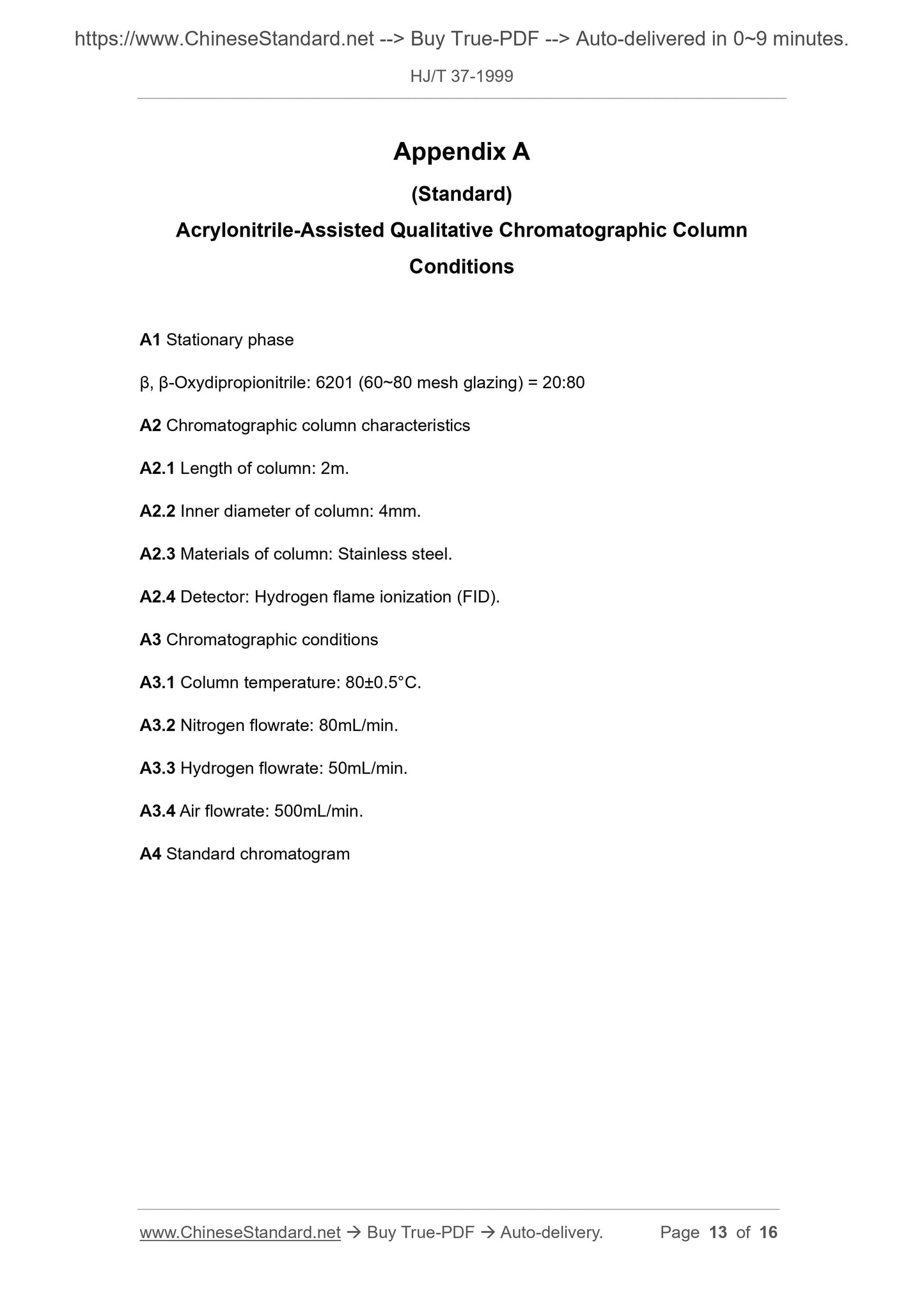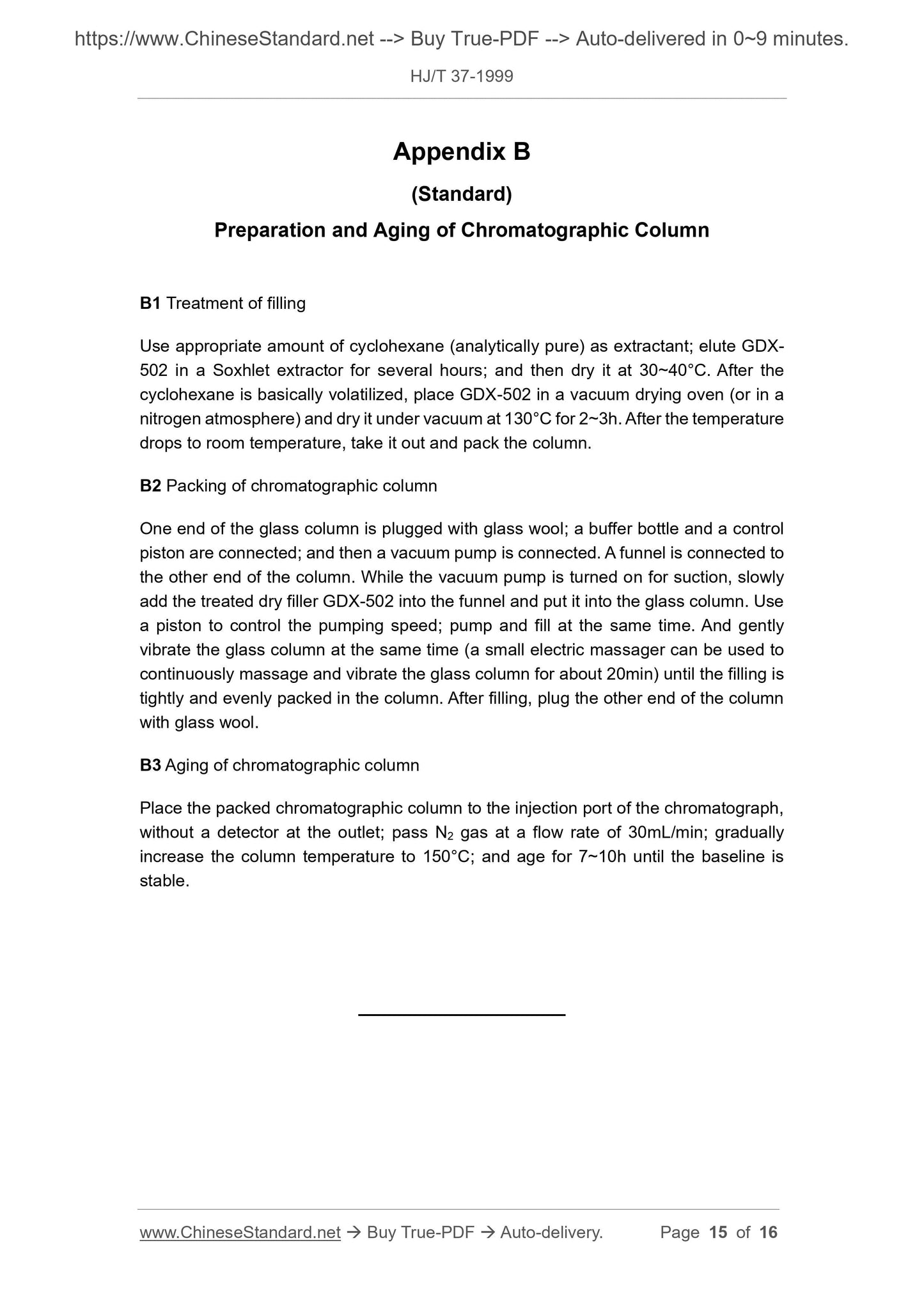1
/
of
9
PayPal, credit cards. Download editable-PDF and invoice in 1 second!
HJ/T 37-1999 English PDF (HJT37-1999)
HJ/T 37-1999 English PDF (HJT37-1999)
Regular price
$170.00 USD
Regular price
Sale price
$170.00 USD
Unit price
/
per
Shipping calculated at checkout.
Couldn't load pickup availability
Delivery: 3 seconds. Download true-PDF + Invoice.
Get QUOTATION in 1-minute: Click HJ/T 37-1999
Historical versions: HJ/T 37-1999
Preview True-PDF (Reload/Scroll if blank)
HJ/T 37-1999: Stationary source emission. Determination of acrylonitrile. Gas chromatography
HJ/T 37-1999
HJ
STANDARD OF STATE ENVIRONMENTAL
PROTECTION ADMINISTRATION
Stationary Source Emission -
Determination of Acrylonitrile - Gas Chromatography
ISSUED ON: AUGUST 18, 1999
IMPLEMENTED ON: JANUARY 01, 2000
Issued by: State Environmental Protection Administration
Table of Contents
1 Scope of Application ... 3
2 Method Principle ... 3
3 Normative References ... 3
4 Reagents and Materials ... 3
5 Instruments ... 5
6 Sample Collection and Storage ... 6
7 Analysis Procedures ... 8
8 Calculation and Representation of Result ... 9
9 Precision and Accuracy ... 12
10 Description ... 12
Appendix A (Standard) Acrylonitrile-Assisted Qualitative Chromatographic
Column Conditions ... 13
Appendix B (Standard) Preparation and Aging of Chromatographic Column . 15
Additional Instructions: ... 16
Stationary Source Emission -
Determination of Acrylonitrile - Gas Chromatography
1 Scope of Application
1.1 This standard is applicable to the determination of acrylonitrile for both intentional
and fugitive emissions from stationary pollution sources.
1.2 When the sampling volume is 30L, the detection limit of the method is 0.2 mg/m3.
The quantitative measurement concentration range of the method is 0.26~33.0mg/m3.
2 Method Principle
Acrylonitrile (CH2=CHCH2CN) is adsorbed and enriched by activated charcoal at room
temperature; and then desorbed by carbon disulfide at room temperature. The
components in the desorbed liquid are separated by the chromatographic column and
then enter the hydrogen flame ionization detector (FID). From the measured
acrylonitrile chromatogram peak height (or area), quantify the concentration of
acrylonitrile in the desorption solution; and finally calculate the concentration of
acrylonitrile in the gas sample from the volume, concentration, and sampling volume
of the desorption solution.
3 Normative References
The provisions in following documents become the provisions of this Standard through
reference in this Standard:
GB 16297-1996 Comprehensive Emission Standard of Air Pollutants
GB 16157-1996 The Determination of Particulates and Sampling Methods of
Gaseous Pollutants Emitted from Exhaust Gas of Stationary Source
4 Reagents and Materials
4.1 Acrylonitrile: Chromatographically pure (or analytically pure, but there must be no
chromatographic interference peaks for acrylonitrile).
and dilute to the mark with carbon disulfide.
5 Instruments
5.1 Gas chromatograph: Equipped with hydrogen flame ionization detector
5.2 Chromatographic column
5.2.1 Column material: Glass or PTFE.
5.2.2 Column length: 3m.
5.2.3 Column inner diameter: 3mm.
5.2.4 Column type: packed column.
5.2.5 In-column packing: GDX-502, 60~80mesh.
5.2.6 Preparation and aging of chromatographic column (see Appendix B).
5.3 Micro syringe: 1.0µL
5.4 Sampling instrument
Refer to 9.3 in GB 16157-1996 to configure the sampling instrument.
5.4.1 Sampling instrument for intentional emission monitoring
5.4.1.1 Sampling tube
It is made of stainless steel, hard glass or PTFE, with appropriate dimensions, and is
equipped with an insulation jacket that can be heated to above 120°C.
5.4.1.2 Sample collecting device
Activated charcoal adsorption tube (4.7).
5.4.1.3 Flowrate measuring device
See 9.3.6 of GB 16157-1996.
5.4.1.4 Suction pump
See 9.3.7 of GB 16157-1996.
5.4.1.5 Connecting pipe
PTFE hose or silicone rubber tube lined with PTFE film.
1-flue; 2-heating sampler; 3-bypass adsorption tube; 4-thermometer; 5-pressure
gauge; 6-adsorption tube; 7-three-way valve; 8-dryer; 9-flow meter; 10- suction pump.
Figure 2 – Flue Gas Sampling System
6.1.3 Sample collection
Plug an appropriate amount of glass wool into the port of the sampling tube; then
extend it to the sampling point in the exhaust cylinder; start the suction pump; and first
make the gas in the exhaust cylinder circulate flow through the bypass adsorption tube
to fully wash the sampling pipeline. Then let the exhaust gas pass through the
adsorption tube; and record the sampling time, temperature, and flow rate. After
sampling, the adsorption tube shall be removed immediately; and its two ends shall be
tightly covered by plastic caps; and then take back to the laboratory for analysis.
6.1.4 Heating temperature control of sampling tube
The heating temperature of the sampling tube shall be based on the principle that water
vapor and the sample do not condense on the wall of the sampling tube; but the
maximum heating temperature shall not exceed 160°C. If the exhaust gas temperature
is close to room temperature, the sampling tube is exempted from being heated.
6.1.5 Sampling flowrate
The sampling flowrate shall generally be controlled between 0.3L/min and 1.0L/min.
When the temperature is higher than 30°C, the sampling flow rate shall be reduced to
no greater than 0.5L/min; so that ensure that the adsorption capacity of the activated
charcoal in the Section-B is less than 2% of the total adsorption capacity.
6.1.6 Sampling amount
For each activated charcoal adsorption tube, the sampling amount shall be controlled
to the concentration of acrylonitrile in the carbon disulfide desorption solution at
10~400µg/mL. The maximum sampling amount of each activated charcoal adsorption
tube shall generally not exceed 1.6mg; and the acrylonitrile adsorbed by the activated
charcoal in Section-B shall not exceed 2% of the total adsorbed amount of acrylonitrile.
6.2 Sample collection of fugitive emissions
6.2.1 Sampling location and sampling point
Determine the location of the fugitive emission monitoring point according to the
provisions of Appendix C in GB 16297-1996; or determine the location of the sampling
point according to other specific requirements.
6.2.2 Connection of sampling device
The solutions of each concentration are injected for three times; take the average value;
and draw the calibration curve by the concentration ci (µg/ml) and the corresponding
peak height hi (or area Ai); and calculate the linear regression equation of the
calibration curve.
7.3 Sample determination
7.3.1 Desorption of the sample
Open the caps at both ends of the activated charcoal adsorption tube after collecting
the sample; use a hooked iron wire to take out the V-shaped spring hook pressed on
the activated charcoal particles in Section-A; and respectively transfer the activated
charcoal in Section-A (including the upper end of glass wool) and the activated
charcoal in Section-B (including sponge) to two dry test tubes with grinding mouths;
and immediately used a pipette to pipette 2.00mL and 1.00mL of carbon disulfide; and
respectively put them into the test tubes containing Section-A and Section-B activated
charcoal. Quickly close the test tube stopper; and continue to gently shake the test
tube; so that the carbon disulfide can be fully contacted and mixed with the activated
charcoal. After 30min, perform gas chromatographic determination.
7.3.2 Gas chromatographic determination
Adjust the instrument according to the same gas chromatographic working conditions
for drawing the calibration curve; and perform gas chromatographic determinations on
the carbon disulfide desorbed liquids that obtain the activated carbon in Section-A and
Section-B in 7.3.1. Take the supernatant of the desorbed solution and inject the sample;
each injection volume is 1.0μL; repeat the injection for three times; and take the
average value of the acr...
Get QUOTATION in 1-minute: Click HJ/T 37-1999
Historical versions: HJ/T 37-1999
Preview True-PDF (Reload/Scroll if blank)
HJ/T 37-1999: Stationary source emission. Determination of acrylonitrile. Gas chromatography
HJ/T 37-1999
HJ
STANDARD OF STATE ENVIRONMENTAL
PROTECTION ADMINISTRATION
Stationary Source Emission -
Determination of Acrylonitrile - Gas Chromatography
ISSUED ON: AUGUST 18, 1999
IMPLEMENTED ON: JANUARY 01, 2000
Issued by: State Environmental Protection Administration
Table of Contents
1 Scope of Application ... 3
2 Method Principle ... 3
3 Normative References ... 3
4 Reagents and Materials ... 3
5 Instruments ... 5
6 Sample Collection and Storage ... 6
7 Analysis Procedures ... 8
8 Calculation and Representation of Result ... 9
9 Precision and Accuracy ... 12
10 Description ... 12
Appendix A (Standard) Acrylonitrile-Assisted Qualitative Chromatographic
Column Conditions ... 13
Appendix B (Standard) Preparation and Aging of Chromatographic Column . 15
Additional Instructions: ... 16
Stationary Source Emission -
Determination of Acrylonitrile - Gas Chromatography
1 Scope of Application
1.1 This standard is applicable to the determination of acrylonitrile for both intentional
and fugitive emissions from stationary pollution sources.
1.2 When the sampling volume is 30L, the detection limit of the method is 0.2 mg/m3.
The quantitative measurement concentration range of the method is 0.26~33.0mg/m3.
2 Method Principle
Acrylonitrile (CH2=CHCH2CN) is adsorbed and enriched by activated charcoal at room
temperature; and then desorbed by carbon disulfide at room temperature. The
components in the desorbed liquid are separated by the chromatographic column and
then enter the hydrogen flame ionization detector (FID). From the measured
acrylonitrile chromatogram peak height (or area), quantify the concentration of
acrylonitrile in the desorption solution; and finally calculate the concentration of
acrylonitrile in the gas sample from the volume, concentration, and sampling volume
of the desorption solution.
3 Normative References
The provisions in following documents become the provisions of this Standard through
reference in this Standard:
GB 16297-1996 Comprehensive Emission Standard of Air Pollutants
GB 16157-1996 The Determination of Particulates and Sampling Methods of
Gaseous Pollutants Emitted from Exhaust Gas of Stationary Source
4 Reagents and Materials
4.1 Acrylonitrile: Chromatographically pure (or analytically pure, but there must be no
chromatographic interference peaks for acrylonitrile).
and dilute to the mark with carbon disulfide.
5 Instruments
5.1 Gas chromatograph: Equipped with hydrogen flame ionization detector
5.2 Chromatographic column
5.2.1 Column material: Glass or PTFE.
5.2.2 Column length: 3m.
5.2.3 Column inner diameter: 3mm.
5.2.4 Column type: packed column.
5.2.5 In-column packing: GDX-502, 60~80mesh.
5.2.6 Preparation and aging of chromatographic column (see Appendix B).
5.3 Micro syringe: 1.0µL
5.4 Sampling instrument
Refer to 9.3 in GB 16157-1996 to configure the sampling instrument.
5.4.1 Sampling instrument for intentional emission monitoring
5.4.1.1 Sampling tube
It is made of stainless steel, hard glass or PTFE, with appropriate dimensions, and is
equipped with an insulation jacket that can be heated to above 120°C.
5.4.1.2 Sample collecting device
Activated charcoal adsorption tube (4.7).
5.4.1.3 Flowrate measuring device
See 9.3.6 of GB 16157-1996.
5.4.1.4 Suction pump
See 9.3.7 of GB 16157-1996.
5.4.1.5 Connecting pipe
PTFE hose or silicone rubber tube lined with PTFE film.
1-flue; 2-heating sampler; 3-bypass adsorption tube; 4-thermometer; 5-pressure
gauge; 6-adsorption tube; 7-three-way valve; 8-dryer; 9-flow meter; 10- suction pump.
Figure 2 – Flue Gas Sampling System
6.1.3 Sample collection
Plug an appropriate amount of glass wool into the port of the sampling tube; then
extend it to the sampling point in the exhaust cylinder; start the suction pump; and first
make the gas in the exhaust cylinder circulate flow through the bypass adsorption tube
to fully wash the sampling pipeline. Then let the exhaust gas pass through the
adsorption tube; and record the sampling time, temperature, and flow rate. After
sampling, the adsorption tube shall be removed immediately; and its two ends shall be
tightly covered by plastic caps; and then take back to the laboratory for analysis.
6.1.4 Heating temperature control of sampling tube
The heating temperature of the sampling tube shall be based on the principle that water
vapor and the sample do not condense on the wall of the sampling tube; but the
maximum heating temperature shall not exceed 160°C. If the exhaust gas temperature
is close to room temperature, the sampling tube is exempted from being heated.
6.1.5 Sampling flowrate
The sampling flowrate shall generally be controlled between 0.3L/min and 1.0L/min.
When the temperature is higher than 30°C, the sampling flow rate shall be reduced to
no greater than 0.5L/min; so that ensure that the adsorption capacity of the activated
charcoal in the Section-B is less than 2% of the total adsorption capacity.
6.1.6 Sampling amount
For each activated charcoal adsorption tube, the sampling amount shall be controlled
to the concentration of acrylonitrile in the carbon disulfide desorption solution at
10~400µg/mL. The maximum sampling amount of each activated charcoal adsorption
tube shall generally not exceed 1.6mg; and the acrylonitrile adsorbed by the activated
charcoal in Section-B shall not exceed 2% of the total adsorbed amount of acrylonitrile.
6.2 Sample collection of fugitive emissions
6.2.1 Sampling location and sampling point
Determine the location of the fugitive emission monitoring point according to the
provisions of Appendix C in GB 16297-1996; or determine the location of the sampling
point according to other specific requirements.
6.2.2 Connection of sampling device
The solutions of each concentration are injected for three times; take the average value;
and draw the calibration curve by the concentration ci (µg/ml) and the corresponding
peak height hi (or area Ai); and calculate the linear regression equation of the
calibration curve.
7.3 Sample determination
7.3.1 Desorption of the sample
Open the caps at both ends of the activated charcoal adsorption tube after collecting
the sample; use a hooked iron wire to take out the V-shaped spring hook pressed on
the activated charcoal particles in Section-A; and respectively transfer the activated
charcoal in Section-A (including the upper end of glass wool) and the activated
charcoal in Section-B (including sponge) to two dry test tubes with grinding mouths;
and immediately used a pipette to pipette 2.00mL and 1.00mL of carbon disulfide; and
respectively put them into the test tubes containing Section-A and Section-B activated
charcoal. Quickly close the test tube stopper; and continue to gently shake the test
tube; so that the carbon disulfide can be fully contacted and mixed with the activated
charcoal. After 30min, perform gas chromatographic determination.
7.3.2 Gas chromatographic determination
Adjust the instrument according to the same gas chromatographic working conditions
for drawing the calibration curve; and perform gas chromatographic determinations on
the carbon disulfide desorbed liquids that obtain the activated carbon in Section-A and
Section-B in 7.3.1. Take the supernatant of the desorbed solution and inject the sample;
each injection volume is 1.0μL; repeat the injection for three times; and take the
average value of the acr...
Share
